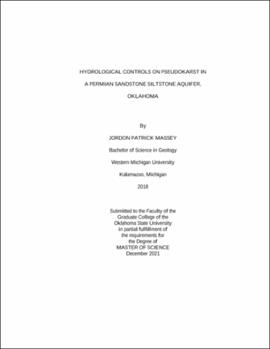| dc.contributor.advisor | Halihan, Todd | |
| dc.contributor.author | Massey, Jordon Patrick | |
| dc.date.accessioned | 2023-03-16T16:56:46Z | |
| dc.date.available | 2023-03-16T16:56:46Z | |
| dc.date.issued | 2021-12 | |
| dc.identifier.uri | https://hdl.handle.net/11244/337107 | |
| dc.description.abstract | Pseudokarst formation is a combination of both dissolution and piping processes (collectively referred to as arenization), that both contribute to the removal of subsurface mass along preferential pathways. Much of the focus of pseudokarst formation research literature has been centered around the dissolution mechanism for quartz arenite sandstone aquifers. As quartz sediment is relatively insoluble, this focus on the process of dissolution limits the understanding of pseudokarst formation by not evaluating the effects of sediment piping along preferential pathways. This study uses hydrological, geophysical and land survey data to delineate how the piping aspect of arenization through fine grained units contributes to the development of pseudokarst in a weakly bonded sandstone siltstone in Stillwater, Oklahoma. Using pressure transducers, water level and electrical conductivity (EC) data were collected from groundwater and surface water locations, and demonstrated the presence of low permeability sediment slopes covering the aquifer resulting in a strong horizontal hydraulic gradient of 0.114 during storm events. Two electrical resistivity images (ERI) and one Temporal ERI (TERI) were collected across the field site. The ER data illustrated the geologic structure of a slope with significant pseudokarst development. Data from the temporal ERI delineated the location of the dominant flow path for the study area. GPS and well data were collected to quantify the location of sinkholes and elevations of lithological changes in the study site. At this field site, the water is focused along pseudokarst pipes in a bedding plane in the siltstone, leading to the arenization of material along these preferential flow pathways. Integrated analysis of hydrological, geophysical and land survey data showed the importance of vertical permeability variations in fine grained siltstone units and clay residual controlling the flowpaths which allow dissolution and piping from the system. Contrary to current literature, these results demonstrate the importance of fine grain units and residual sediments as hydrogeologic controls of pseudokarst development. | |
| dc.format | application/pdf | |
| dc.language | en_US | |
| dc.rights | Copyright is held by the author who has granted the Oklahoma State University Library the non-exclusive right to share this material in its institutional repository. Contact Digital Library Services at lib-dls@okstate.edu or 405-744-9161 for the permission policy on the use, reproduction or distribution of this material. | |
| dc.title | Hydrological controls on pseudokarst in a permerian sandstone siltstone aquifer | |
| dc.contributor.committeeMember | Riedinger, Natascha | |
| dc.contributor.committeeMember | Vilcaez, Javier | |
| osu.filename | Massey_okstate_0664M_17457.pdf | |
| osu.accesstype | Open Access | |
| dc.type.genre | Thesis | |
| dc.type.material | Text | |
| dc.subject.keywords | arenization | |
| dc.subject.keywords | low permeability | |
| dc.subject.keywords | pseuodkarst | |
| dc.subject.keywords | sandstone | |
| dc.subject.keywords | siltstone | |
| thesis.degree.discipline | Geology | |
| thesis.degree.grantor | Oklahoma State University | |
